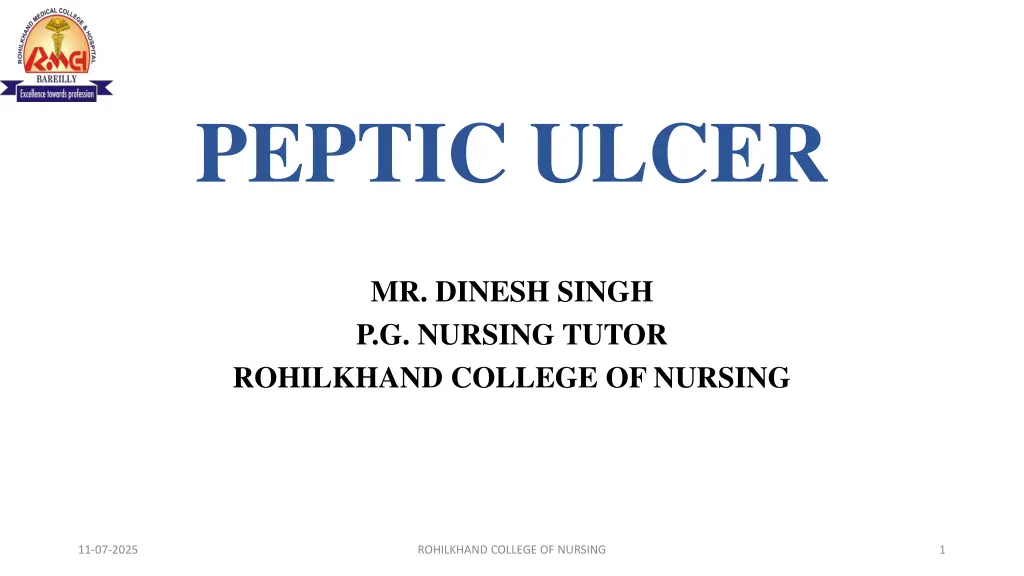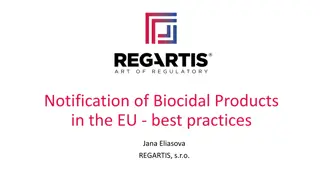
Understanding Peptic Ulcers and Peritonitis
Learn about peptic ulcers, their causes, symptoms, and management, along with an overview of peritonitis - its definition, etiology, and prevention methods.
Download Presentation

Please find below an Image/Link to download the presentation.
The content on the website is provided AS IS for your information and personal use only. It may not be sold, licensed, or shared on other websites without obtaining consent from the author. If you encounter any issues during the download, it is possible that the publisher has removed the file from their server.
You are allowed to download the files provided on this website for personal or commercial use, subject to the condition that they are used lawfully. All files are the property of their respective owners.
The content on the website is provided AS IS for your information and personal use only. It may not be sold, licensed, or shared on other websites without obtaining consent from the author.
E N D
Presentation Transcript
PEPTIC ULCER MR. DINESH SINGH P.G. NURSING TUTOR ROHILKHAND COLLEGE OF NURSING 11-07-2025 ROHILKHAND COLLEGE OF NURSING 1
OBJECTIVES Introduction of the Peritonitis. Define the Peritonitis. Explain the causes of Peritonitis. State the clinical manifestations of Peritonitis. Elaborate the diagnostic evaluation of Peritonitis. Discuss the management of Peritonitis. Describe the prevention of Peritonitis. 11-07-2025 ROHILKHAND COLLEGE OF NURSING 2
INTRODUCTION Peptic ulcers are open sores that develop on the inside lining of the stomach and the upper portion of the small intestine. The most common symptom of a peptic ulcer is stomach pain. Peptic ulcers include: Gastric ulcers that occur on the inside of the stomach Duodenal ulcers that occur on the inside of the upper portion of the small intestine (duodenum) 11-07-2025 ROHILKHAND COLLEGE OF NURSING 3
DEFINITION It is defined as a breakdown in continuity of mucous membrane of duodenum, esophagus, stomach or a breach in lining (mucosa) of digestive tract produced by digestion of mucosa by pepsin and acid are present in abnormally high concentrations. 11-07-2025 ROHILKHAND COLLEGE OF NURSING 4
ETIOLOGY Genetic Prolonged excessive stress Prolonged use of some drugs, NSAID, corticosteroid, antiplatelets. Excessive intake of caffeine, alcohol Fasting or resting period Emotional stress Infection by bacteria 11-07-2025 ROHILKHAND COLLEGE OF NURSING 5
TYPES 1. Gastric Ulcer: It is breaking of mucous membrane of stomach due to some injuries like substances, alcohol, caffeine, aspirin, NSAID drugs. 2. Duodenal Ulcer: They occur in duodenum due to stimulation of vagus nerve during resting period or fasting. 3. Oesophageal Ulcer: Ulcerations in mucosa of oesophagus. It is due to hydrochloric acid reflux in oesophagus (mostly seen in lower oesophagus). 11-07-2025 ROHILKHAND COLLEGE OF NURSING 6
11-07-2025 ROHILKHAND COLLEGE OF NURSING 7
PATHOPHYSIOLOGY 1. Gastric Ulcer Due to (NSAIDs), alcohol, coffee or tea Excessive secretion of HCL and decrease mucous secretion Breakdown mucus membrane of stomach Acid enters into gastric mucosa Gastric ulcers 11-07-2025 ROHILKHAND COLLEGE OF NURSING 8
2. Duodenal Ulcer Due to fasting Stimulation of vagus nerve Increases gastric secretion HCl secretion level increase That lead to duodenal ulcer 11-07-2025 ROHILKHAND COLLEGE OF NURSING 9
CLINICAL MANIFESTATION Epigastric pain Hypochondrium region pain Nausea Vomiting (sometimes with blood) Discomfort Anorexia (loss of appetite) Weight loss Bloody stool Dyspepsia (indigestion) Hip and knee pain Heart burn 11-07-2025 ROHILKHAND COLLEGE OF NURSING 10
DIAGNOSTIC EVALUATION History collection Physical examination Endoscopy: Visualization of the stomach ulcers and doctor detects an ulcer, a small tissue sample (biopsy) may be removed for examination in a lab. A biopsy can also identify whether H. pylori is in patient stomach lining. Ultrasound Complete blood count 11-07-2025 ROHILKHAND COLLEGE OF NURSING 11
MANAGEMENT Antimicrobial Drugs: Prevent and treat infections. Eg. Metronidazole H2- Blocker: Block H2 recepter (that leads to hypersecretion of acid gastric juice). Eg. Ranitidine Antacids: Nutralizes HCl Secresion, Eg. Aluminum hydroxide, Calcium Carbonate, Magnesium hydroxide, Sodium bicarbonate Proton pump inhibitors: Reducing the amount of stomach acid made by glands in the lining of the stomach. Eg. Lansoprazole, Omeprazole. 11-07-2025 ROHILKHAND COLLEGE OF NURSING 12
SURGICAL MANAGEMENT 1. Vagotomy: Cutting of vagus nerve 2. Gastro jejunostomy: Remove the antrum part of stomach and join with remaining part of jejunum. 3. Gastroduodenostomy: Removal of lower portion of stomach and join with remaining part of duodenum. 4. Subtotal Gastrectomy: Removal that portion which is more effected by ulcer in stomach. 5. Total gastrectomy: Total removal of stomach. 11-07-2025 ROHILKHAND COLLEGE OF NURSING 13
11-07-2025 ROHILKHAND COLLEGE OF NURSING 14
11-07-2025 ROHILKHAND COLLEGE OF NURSING 15
11-07-2025 ROHILKHAND COLLEGE OF NURSING 16
SUMMARY 11-07-2025 ROHILKHAND COLLEGE OF NURSING 17
REFERENCES 11-07-2025 ROHILKHAND COLLEGE OF NURSING 18
11-07-2025 ROHILKHAND COLLEGE OF NURSING 19




